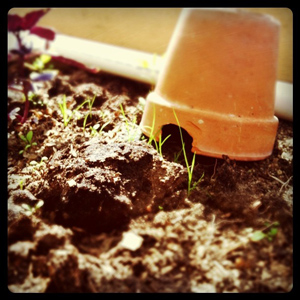by Liz Magnanti

Toad house—Photo courtesy Flickr: Noah Sussman
Spring is here! Flowers are blooming, birds are singing, and animals are out of hibernation. This is a very active time for wildlife. They are looking for food, mates, and a place to roost and raise their young. There are many different types of houses and habitats you can set up in your yard to attract a diversity of wildlife.
Bird houses are the most popular type of wildlife habitat you can set up in your yard. They provide birds with a place to build their nests, lay their eggs, and raise their young. The size of the house and the entrance hole will dictate what type of bird may use it. Bluebirds, sparrows, wrens, chickadees and woodpeckers actively and commonly use bird houses. If you get a large enough house you may even get a screech owl! One very important feature to look for when picking out a birdhouse is that it has a door or hatch that opens to clean out the nest once the young have fledged. If the bird has more than one brood a year it will build a new nest.
Brush piles are a fantastic way to attract a large diversity of wildlife. They are great hiding places for rabbits, chipmunks, woodchucks, and even reptiles and amphibians. Start by taking large sticks and logs and layering them on the ground. Build the pile up with smaller sticks and grasses. This little shelter can become a perching place for birds, butterflies, and moths, as well as smaller wildlife, to take shelter.
In New York we have a variety of bats that will roost in old structures, caves and bat houses. If you would like to attract these night-flying voracious insect eaters, put up a bat house. Bat houses should be painted black or dark brown to absorb heat. It should be at least 15 feet off the ground and free of obstructions below it. Bat houses require very little maintenance. Once they have been put up they just need to be checked periodically to make sure wasps haven’t moved in. Bat populations have been suffering lately, so having extra places for their populationsmto recover and grow is very important.
Mason bees (see our September-October 2017 issue for more) are small, native, non-stinging bees. They get their name from their habit of constructing nests out of mud or other “masonry”-type material. In the United States we have about 140 different species. Mason bees are not social insects, but are solitary in nature. They are smaller than honeybees in size and only live for about eight weeks in the spring. After mating, the male bees die and the females construct their nests in hollow tubular cavities and small spaces. Once a nest site has been selected the female will visit flowers collecting pollen and nectar. She lays her eggs in her nest site on top of a collected nectar and pollen “packet” and covers the cavity entrance up with mud to protect it. This process is done over and over until the hollow cavity is filled. When the eggs hatch, the larvae feed on the pollen and nectar. They form a pupa where they will hibernate until the spring. Once they are fully formed the young bees will chew their way out to begin the process over again.
Ever break a pot in the garden and feel terrible about it? Now those shards have a purpose! You can turn your old pottery into a toad house. Toad houses are traditionally clay pots that have a semi-circle shape cut out of their rim, but your chipped pots can be tipped upside down and placed in the garden as a little hideout for toads. They should be placed in an area lit by porch lights, if possible, so toads can feast on the insects they attract at night. Try to keep your toad house in a damp area, where the toads can absorb some water through their skin to get rehydrated.
Spring is a great time to prep your yard for the year ahead. Having habitats for wildlife is beneficial all year long. The more habitats you create, the more sights and sounds you will bring to the garden.
Liz Magnanti is manager of the Bird House in Brighton.
Views: 0




